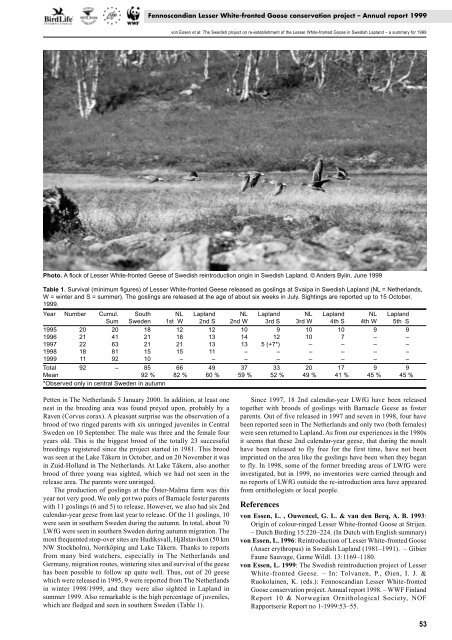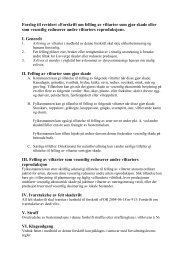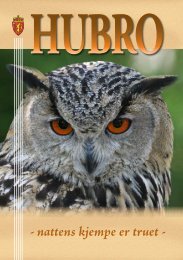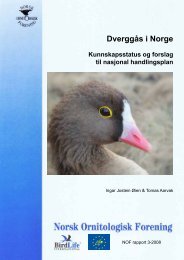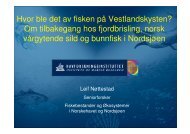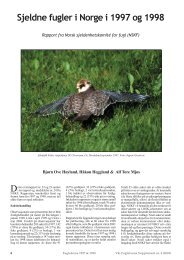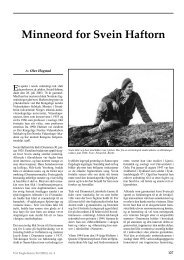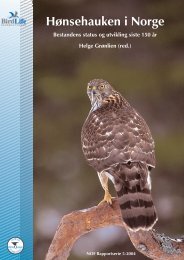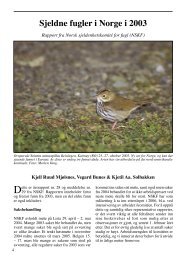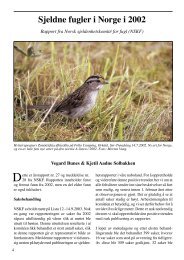Fennoscandian Lesser White-fronted Goose conservation project ...
Fennoscandian Lesser White-fronted Goose conservation project ...
Fennoscandian Lesser White-fronted Goose conservation project ...
You also want an ePaper? Increase the reach of your titles
YUMPU automatically turns print PDFs into web optimized ePapers that Google loves.
<strong>Fennoscandian</strong> <strong>Lesser</strong> <strong>White</strong>-<strong>fronted</strong> <strong>Goose</strong> <strong>conservation</strong> <strong>project</strong> – Annual report 1999<br />
Photo. A flock of <strong>Lesser</strong> <strong>White</strong>-<strong>fronted</strong> Geese of Swedish reintroduction origin in Swedish Lapland. © Anders Bylin, June 1999<br />
Table 1. Survival (minimum figures) of <strong>Lesser</strong> <strong>White</strong>-<strong>fronted</strong> Geese released as goslings at Svaipa in Swedish Lapland (NL = Netherlands,<br />
W = winter and S = summer). The goslings are released at the age of about six weeks in July. Sightings are reported up to 15 October,<br />
1999.<br />
Year Number Cumul. South NL Lapland NL Lapland NL Lapland NL Lapland<br />
Sum Sweden 1st W 2nd S 2nd W 3rd S 3rd W 4th S 4th W 5th S<br />
1995 20 20 18 12 12 10 9 10 10 9 9<br />
1996 21 41 21 18 13 14 12 10 7 – –<br />
1997 22 63 21 21 13 13 5 (+7*) – – – –<br />
1998 18 81 15 15 11 – – – – – –<br />
1999 11 92 10 – – – – – – – –<br />
Total 92 – 85 66 49 37 33 20 17 9 9<br />
Mean 92 % 82 % 60 % 59 % 52 % 49 % 41 % 45 % 45 %<br />
*Observed only in central Sweden in autumn<br />
Petten in The Netherlands 5 January 2000. In addition, at least one<br />
nest in the breeding area was found preyed upon, probably by a<br />
Raven (Corvus corax). A pleasant surprise was the observation of a<br />
brood of two ringed parents with six unringed juveniles in Central<br />
Sweden on 10 September. The male was three and the female four<br />
years old. This is the biggest brood of the totally 23 successful<br />
breedings registered since the <strong>project</strong> started in 1981. This brood<br />
was seen at the Lake Tåkern in October, and on 20 November it was<br />
in Zuid-Holland in The Netherlands. At Lake Tåkern, also another<br />
brood of three young was sighted, which we had not seen in the<br />
release area. The parents were unringed.<br />
The production of goslings at the Öster-Malma farm was this<br />
year not very good. We only got two pairs of Barnacle foster parents<br />
with 11 goslings (6 and 5) to release. However, we also had six 2nd<br />
calendar-year geese from last year to release. Of the 11 goslings, 10<br />
were seen in southern Sweden during the autumn. In total, about 70<br />
LWfG were seen in southern Sweden during autumn migration. The<br />
most frequented stop-over sites are Hudiksvall, Hjälstaviken (50 km<br />
NW Stockholm), Norrköping and Lake Tåkern. Thanks to reports<br />
from many bird watchers, especially in The Netherlands and<br />
Germany, migration routes, wintering sites and survival of the geese<br />
has been possible to follow up quite well. Thus, out of 20 geese<br />
which were released in 1995, 9 were reported from The Netherlands<br />
in winter 1998/1999, and they were also sighted in Lapland in<br />
summer 1999. Also remarkable is the high percentage of juveniles,<br />
which are fledged and seen in southern Sweden (Table 1).<br />
von Essen et al: The Swedish <strong>project</strong> on re-establishment of the <strong>Lesser</strong> <strong>White</strong>-<strong>fronted</strong> <strong>Goose</strong> in Swedish Lapland – a summary for 1999<br />
Since 1997, 18 2nd calendar-year LWfG have been released<br />
together with broods of goslings with Barnacle Geese as foster<br />
parents. Out of five released in 1997 and seven in 1998, four have<br />
been reported seen in The Netherlands and only two (both females)<br />
were seen returned to Lapland. As from our experiences in the 1980s<br />
it seems that these 2nd calendar-year geese, that during the moult<br />
have been released to fly free for the first time, have not been<br />
imprinted on the area like the goslings have been when they began<br />
to fly. In 1998, some of the former breeding areas of LWfG were<br />
investigated, but in 1999, no inventories were carried through and<br />
no reports of LWfG outside the re-introduction area have appeared<br />
from ornithologists or local people.<br />
References<br />
von Essen, L. , Ouweneel, G. L. & van den Berq, A. B. 1993:<br />
Origin of colour-ringed <strong>Lesser</strong> <strong>White</strong>-<strong>fronted</strong> <strong>Goose</strong> at Strijen.<br />
– Dutch Birding 15:220–224. (In Dutch with English summary)<br />
von Essen, L. 1996: Reintroduction of <strong>Lesser</strong> <strong>White</strong>-<strong>fronted</strong> <strong>Goose</strong><br />
(Anser erythropus) in Swedish Lapland (1981–1991). – Gibier<br />
Faune Sauvage, Game Wildl. 13:1169–1180.<br />
von Essen, L. 1999: The Swedish reintroduction <strong>project</strong> of <strong>Lesser</strong><br />
<strong>White</strong>-<strong>fronted</strong> Geese. – In: Tolvanen, P., Øien, I. J. &<br />
Ruokolainen, K. (eds.): <strong>Fennoscandian</strong> <strong>Lesser</strong> <strong>White</strong>-<strong>fronted</strong><br />
<strong>Goose</strong> <strong>conservation</strong> <strong>project</strong>. Annual report 1998. – WWF Finland<br />
Report 10 & Norwegian Ornithological Society, NOF<br />
Rapportserie Report no 1-1999:53–55.<br />
53


